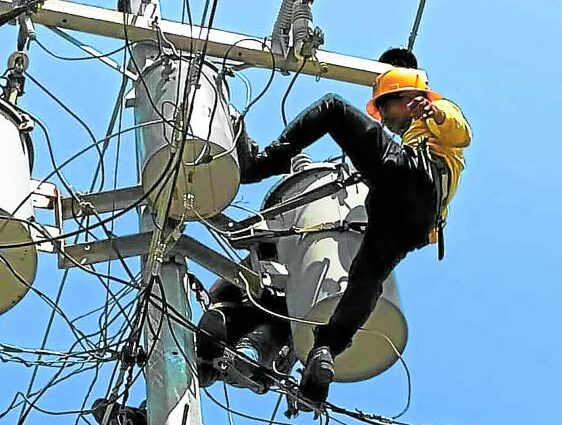Gov’t talks to power firm to end Occidental Mindoro blackouts

POWERING UP | Two linemen for the Occidental Mindoro Electric Cooperative fix electric power cables connected to transformers days before the sole electricity supplier for the province agreed to run all its three generators at full capacity to end the weekslong outage. (CONTRIBUTED PHOTO)
Weeks of power outages in Occidental Mindoro, with some days lasting up to 20 hours, ended on Friday after the owner of three power plants in the province resumed full operation despite facing potential financial losses.
The Occidental Mindoro Electric Cooperative (Omeco) said on its Facebook page that there were no more reports of blackouts in the province as of Friday night.
“Full capacity na! (Now at full capacity),” said Omeco, referring to the three power generators operated by Occidental Mindoro Consolidated Power Corp. (OMCPC), Omeco’s sole power supplier.
Omeco said it had successfully supplied the peak demand requirements of 29 megawatts to 30 megawatts to the province, which grappled with hourslong daily power outages since early this month.
According to Omeco, all three OMCPC power plants were running at full combined capacity of over 30 MW.
Article continues after this advertisementThese are the 5-MW power station in Sablayan; the 7-MW plant supplying electricity to Mamburao, Paluan, Sta. Cruz, and Abra de Ilog towns (Mapsa); and the 20-MW station supplying power to the municipalities of San Jose, Magsaysay, Rizal and Calitaan (Samarica).
Article continues after this advertisementThe National Electrification Administration (NEA) said in a statement on Saturday that with all three plants operating, OMCPC would be able to supply about 30 MW to 32 MW to Omeco, “which should result in the substantial lessening, if not complete elimination, of blackouts in the province.”
Occidental Mindoro had a population of 525,354 in 2020, according to a census by the Philippine Statistics Authority. There are around 90,000 electricity subscribers in the province, over 83,000 of which are residential.
Napocor subsidy
Since April 13, OMCPC has been operating only one power generator—the 7.5-MW Samarica power plant—because it did not receive its fuel subsidy from the National Power Corp. (Napocor).
The subsidy is given to private power providers as a form of incentive for operating in off-grid areas like Occidental Mindoro. It is also intended to lower the electricity cost for people in areas not connected to the Luzon, Visayas and Mindanao power grids.
In a report to Malacañang on Friday, the NEA said that Administrator Antonio Mariano Almeda met with OMCPC owner Luis Manuel Banzon on Thursday to discuss remedies to the province’s power crisis.
As a result of the meeting, the company “agreed” to run its three power plants, the NEA said in a statement.
The NEA did not mention the nonpayment of Napocor’s fuel subsidy to OMCPC.
But it said that during the Thursday meeting, it was determined that the “apparent reason” OMCPC was not operating its Sablayan and Mapsa generators was because it was unclear whether OMCPC’s fuel costs could be passed on to consumers through Omeco.
Potential losses
The NEA said OMCPC would run its three power plants despite potential financial losses and not having an approved rate from the Energy Regulatory Commission (ERC) for its Samarica power plant which would enable the company to recoup its losses.
“Banzon’s decision was driven by his desire to help alleviate the power crisis in the province,” the NEA said.
But in a press statement from Presidential Communications Secretary Cheloy Velicaria-Garafil, OMCPC appeared to have been pushed by the NEA to run its power plants.
“Upon the orders of the NEA administrator, the NEA said OMCPC agreed to run its three power facilities notwithstanding any potential financial losses to Banzon and despite not having an approved rate from the ERC for the Samarica power plant which would allow him to recoup his cost of operations,” Garafil said.
“Banzon, while initially hesitant, agreed to operate the power plants … notwithstanding the expected financial losses, to supply residents in the province with electricity,” she said.
The ERC had given provisional approval to the power supply agreements (PSAs) of Sablayan and Mapsa with Omeco while OMCPC was still processing its PSA for Samarica, according to Garafil.
“Before requesting that OMCPC operate its power stations, the NEA official sought the clearance of Department of Energy Secretary Raphael Lotilla, who green-lit the arrangement,” she said.
Garafil said OMCPC was not operating two of its power plants because of the issue of whether its fuel cost was “a pass-through cost.”
The ERC earlier explained that pass-through costs are amounts collected from electricity end-users other than the distribution charge, which is the fee for using the facilities that deliver electricity to consumers.